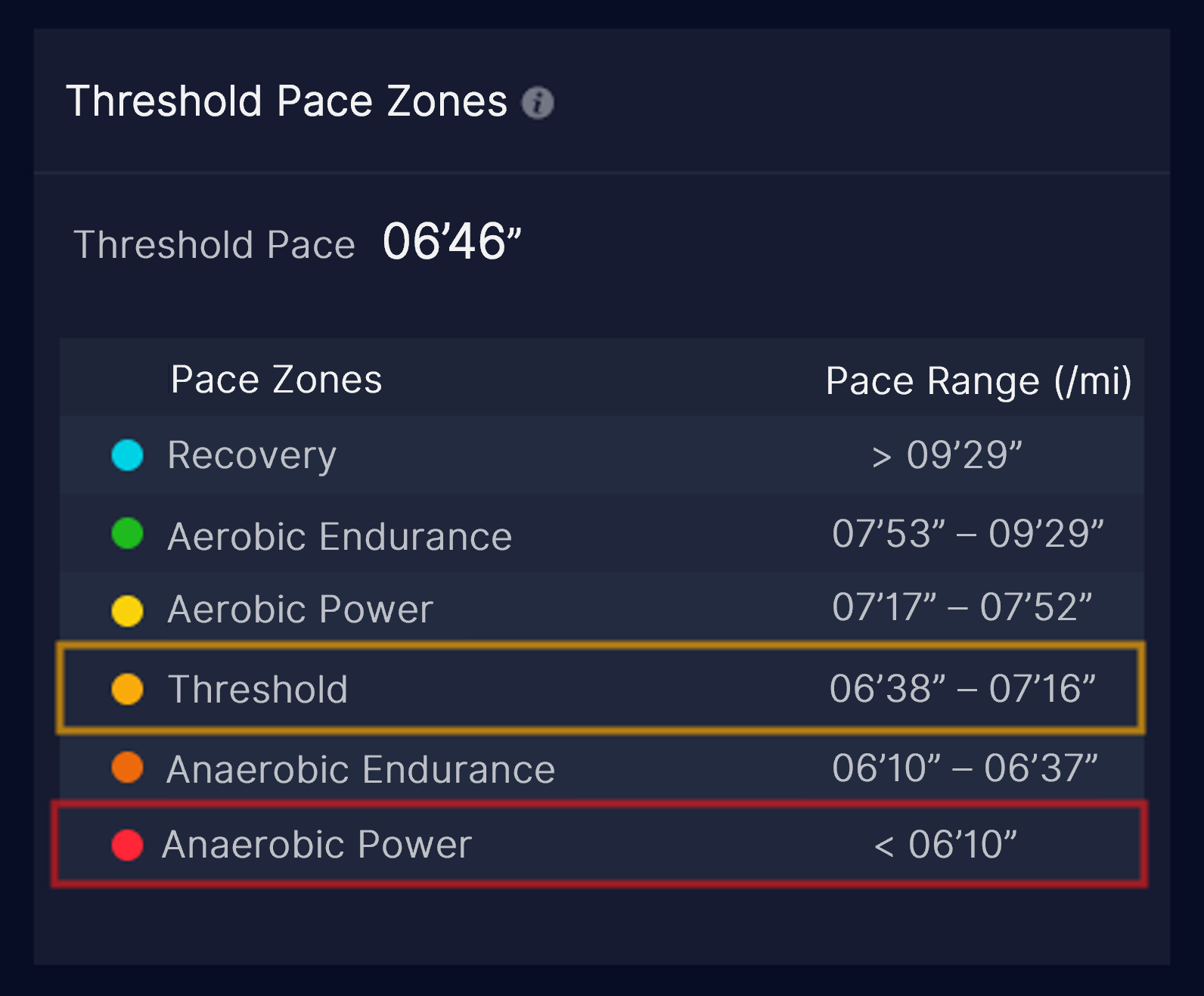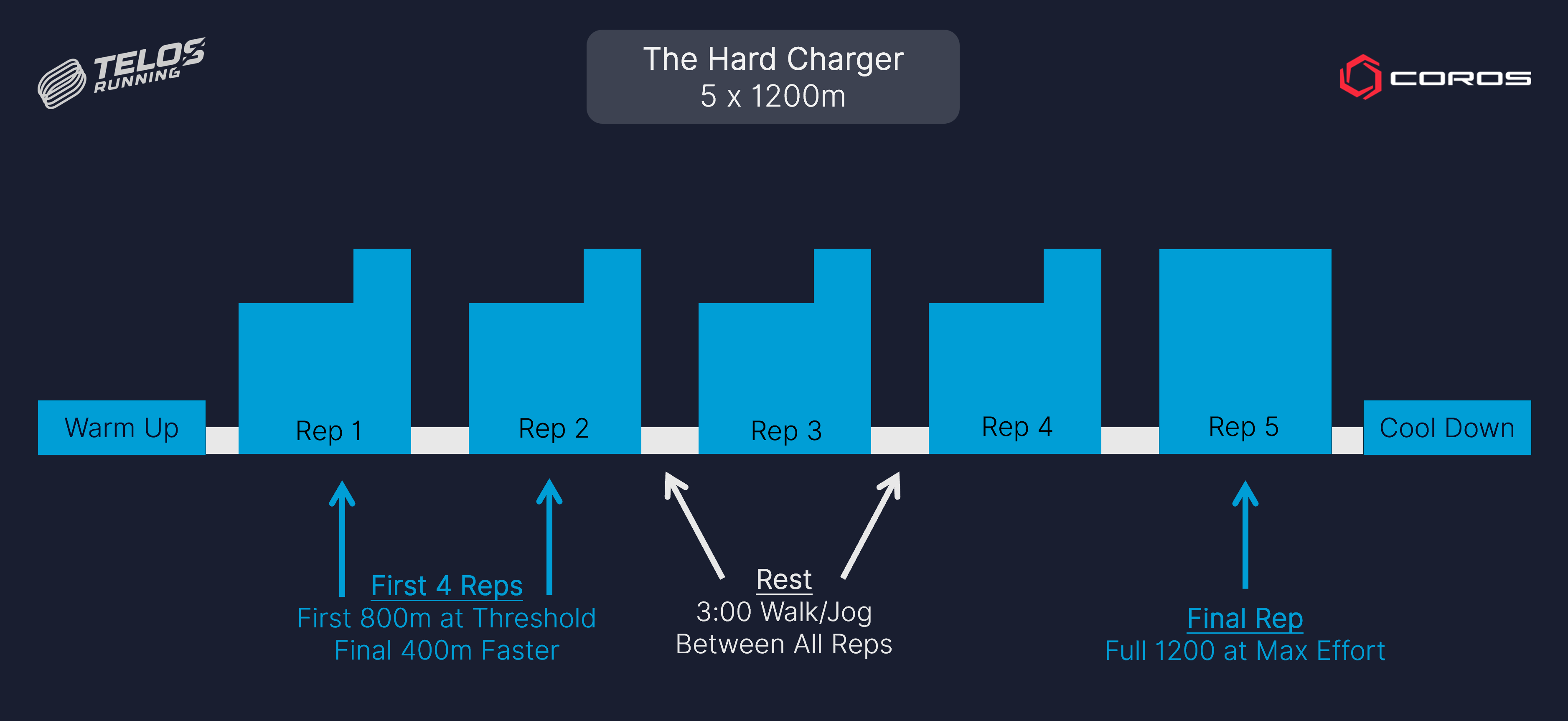Training for a race is more than just fitness - it’s preparing your body for the conditions you’ll experience on race day. Intense sessions often are designed to mimic specific race conditions, forcing your body to meet the demands in a more controlled environment. COROS has partnered with Coach Steve Sisson at Telos Running to highlight these specific sessions for several race distances. Today’s Workout is a 5K Session called the Hard Charger.
Coaches Tip: To perform this workout yourself, you can add it to your training calendar via the COROS Training Hub by clicking here.
The Session:
5 x 1200m (3 laps) w/ 3 min walk/jog rest between each rep. Reps 1-4 are run as written below; the final rep is run as fast as possible.
Location/Surface:
This session is best done on a standard 400m track, but it can easily be accommodated to the roads using the COROS structured workouts Click here to download the workout.
I usually like athletes to take to the track for this one, because it is easier to concentrate and execute with the short, repetitive 400m loop. However, doing this one on the roads is really beneficial if you race the 5K on the road. It prepares you for the mental strain of concentration that is so unique to racing the 5K on the roads.
The Details:
The first two laps of each 1200m should be run at 10K pace, which is the upper-end of the threshold zone. On the third lap, push the pace to something faster. How much faster? If you know your 3K pace, that’s a great target. This pace is typically on the low end of the “Anaerobic Power” zone. If I am working with advanced level athletes, I may ask them to hit their mile or 1500m pace. It’s important to make the first rep a bit exploratory and use the slow end of your fitness range - like the anaerobic endurance zone- to ensure you don’t get this one rolling too early and are unable to finish the last rep hard.

An example of Threshold Pace Zones for a 20:00 5K runner. Zones used for this workout are highlighted.
If an athlete is targeting a 5K goal pace of sub-20 minutes (6:26/mi or 1:36.5/lap), the session would look like this:
Reps 1-4
- Laps 1 & 2: 1:41 →10K pace (6:42/mi)
- Lap 3: 1:35 → 3K pace (6:10/mi)
Rep 5
- Hard Full Effort

A visualization of the Hard Charger workout
Be sure to take the full 3 min walk/jog before the final full effort rep. You want to be as rested as possible - within the three minute limit - to bring your best effort.
On the last 1200m rep, it is critical that you push really hard for all 3 laps... Yes, empty the tank for the full 1200m distance. If you run this session really well, the final 1200m rep time is an excellent indicator of your current 5K fitness. So whatever pace you can hold per mile/400m is a good indicator of the pace you’d be able to sustain over a 5K race distance. Of course, the whole workout requires focus - do not simply sandbag the early part so you can nail the last rep. On the other hand, going too hard on the first four reps will also make it difficult to run your best over the final rep. So being judicious with your effort is very important, which is coincidentally an essential aspect of racing a 5K effectively.
Coaches Tip: For race-specific workouts, it is important to hit the correct paces for maximum benefit. The COROS Training Hub has a metric called effort accuracy to help measure how well you stayed on-pace!
The Purpose:
This session is a true 5K workout. It is designed to simulate a 5K race effort and can be very useful for determining current 5K fitness. It is also a really fun session for turning over and pushing in the middle of a session. Many of the workouts we do in the Telos system are progressions, closes, and sustained efforts. Many runners find drastic pace changes and painful training experiences to be highly stressful. Getting smaller, more manageable bouts of this kind of work can be really helpful in avoiding the nervous system overload and potential mental shutdown that can happen when we are overwhelmed in racing or hard training efforts. Consider this training in dealing with bad patches. In this case, though, the bad patches are manufactured, instead of catching you off-guard in a race effort.
Someone asked me the first time we did this if it was a 10K workout since the majority of the session is done at 10K paces. While it is true that the paces are 10K, the goal/purpose of the session for those racing a 5K is to be able to push hard at the end of a race. If we did this session at 5K paces, we’d have a harder time really accelerating in the final 400m …especially in the final two reps. So to make sure you have the energy to charge, I have you run slower than 5K. If you charge really hard, the average pace will be considerably closer to 5K overall. It’s sneaky like that.
- Coach Steve Sisson, Telos Running
What to Expect:
This one definitely gets harder as it progresses. Adjusting your expectations early to allow your current, true fitness to come through really will make this session a better experience. The 10K pace will feel pretty breezy early on, but expect that hard charge at the end of reps 1 and 2 to take their toll. The session starts to be much more work - both physically & mentally. Additionally, the hard 400m hits need an aggressive mindset that can be hard to summon. Finally, that last fast 1200m is the real deal. If you want to be able to handle the final 5 minutes of a 5K, this is the psychosomatic space you have to be comfortable in. The pain cave is very real.
While this session ends with a very difficult push, be reminded that you are trying to simulate the experience of a race with as much fidelity as possible: this is what the race requires. Anyone who has raced a hard 5K knows that the intensity of this final mile is one of the greatest challenges in distance running. I liken it to the last 200m of an 800m race or the final 5K of a marathon. It is the unique and special task of the 5K race distance. This session allows you to meet that challenge head on.

/filters:quality(90)/fit-in/970x750/coros-web-faq/upload/images/e2e7e09283023a0e56f3da9aba0062e0.png)